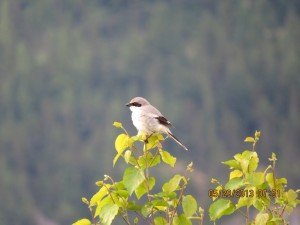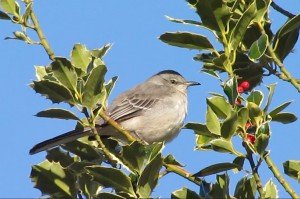By Gagandeep Ghuman
Published: Sept. 28, 2013
Birding enthusiasts in Squamish have found as many as 10 birds unusual to this region flying in our skies.
On May 27 this year, Chris Dale saw a Yellow-breasted Chat, unusual for the Lower Mainland, on the Spit Road.
Two days later, he went there trying to find the Chat but instead found another surprise visitor.
It was a Loggerhead Shrike, a bird rarely found in British Columbia. There have been only two sightings this year in the province.
This May, Marcia Danielson also spotted the Ross’s Goose, another bird unusual for the province.

And seen on the Oceanfront Trail this summer was the Least Flycatcher.
At least 10 birds not native to this region have been found freely roaming our skies.
But it’s not free spirited wanderlust that brings them here.
“Some birds get carried along with the weather,” said local bird enthusiast Chris Dale, a bird enthusiast.
“And you will get certain birds that seem to get confused.”
More bird enthusiasts looking for birds could be another reason for more rare birds being spotted.
“There are more people out and about and more birds are getting noticed,” Dale said.
Last year, there was the Northern Mockingbird, found by Patrick MacNamara near the library.
Then there was the black throated sparrow spotted in the bridge pond area of the estuary.
The Black Throated Sparrow, in fact, is a bird rare to Canada. Only five of these birds have been spotted in the country.
Last year, Hilary Diamond and Wally Fletcher also spotted the Lark Sparrow, rare sight in the Lower Mainland, near the Bridge Pond area of the estuary.
Then, there was the Brown Pelican seen near the boat harbour, the Tundra Swan seen in the central channel of the estuary, and seen around Howe Sound Secondary School, the Snowy Owl, all seen last year, all unusual birds for the Lower Mainland.
Last year, around February, Patrick MacNamara stepped out of the library and saw a curious sight.
There on the lawn of a house right across from the library, a bird flashed its wings, folding them in and turning them out. Then it ran a little, stood still, and flashed its wings again.
MacNamara stood there enchanted.
An avid birder, MacNamara watched closely, came home, checked out his bird guide, and concluded he had seen a Northern Shrike Bird.

What he had seen, in fact, was a Northern Mockingbird, a bird unusual for B.C.
The Northern Mockingbird breeds in southeastern Canada, the United States, Northern Mexico, the Bahamas, the Cayman Island, and the Greater Antilles.
It seemed to like Squamish and stayed around.
He last saw the bird in May staking out a place on the Holly tree across from the Squamish United Church on Fourth Ave.
“He was chasing all the robins away, it was quite a sight,” said MacNamara, chuckling at the memory.
The bird was last seen in Pemberton last year, he added.
Retired and with ‘time to kill,’ he has been keeping an eye out for the Mockingbird, but so far, no luck.
Perhaps you will spot it.
If you are interested in pursuing birding as a hobby or are just interested in it, you can join local bird enthusiasts every second Monday as they walk the estuary and other parts of the town for monthly bird counts.
More details can be found on www.squamishenvironment.ca


Anonymous says
Great to read and read about fellow bird enthusiats. I’ve noticed a decline in cowbirds at my feeder this year and that is a good thing. I don’t know if anyone else noticed the decline in hummingbirds this year. For the first time, I saw a sandpiper type bird running along the street in front of my home. I’ve never seen a sandpiper away from the waters edge before. That was interesting. I also got some shots of an unknown hawk having a meal at Nexen Beach.
heather gee says
Interesting reading, thanks…
Craig says
My wife just had this visitor up in the Highlands.
https://twitter.com/lyrencherlet/status/385852645837008896/photo/1
Can anyone id what kind of bird this is?
Alison says
That’s a Northern Flicker–a member of the woodpecker family.
Craig says
Thanks!
Staven says
This summer we had black headed grosbeak at our feeder, I’d never seen one before this year.